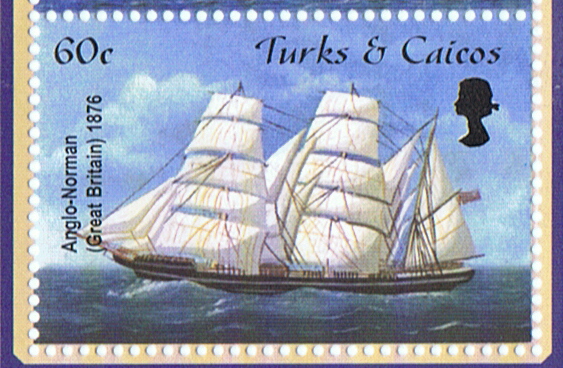
Built as an iron 3 masted barque in 1876 by the yard of Russel and Co. at
Port Glasgow for Frost, Cook & Co.
Launched under the name ANGLO-NORMAN
Tonnage 864 gross, 822 net, dim. 192.4 x 32.2 x 18.9ft.
She made two voyages in the wool trade from Australia, the first in 1882
when she left 10 Jan. from Sydney and arrived 23 April in London after a
voyage of 103 days.
Her second voyage was when she left on 4 Nov. 1883 from Sydney and arrived
at London 1 Feb. 1884 after a voyage of 89 days.
I could not find anything on the other voyages she made under English flag
in my research books.
She was later sold to J. Jeremiassen at Porsgrunn, Norway (who can give the
year when sold). (Log Book gives as owner H.Jeremiassen).
She was lost on 26 Sept. 1914 under command of Capt. H.Jeremiassen on the
North Spit, Kaipara Head, New Zealand.
New Zealand Shipwrecks gives:
At noon that day the barque ANGLO-NORMAN stranded and became a total wreck.
A light south-westerly wind was blowing, but when crossing the bar the
vessel was struck by a squall, and the strong current and heavy sea caused
her to drift ashore. Her crew of 12 landed safely the same evening, and
managed to save their effects. They walked to the lighthouse, where they
received every attention. The shipwrecked crew arrived in Auckland on Sept.
28, and reported to the Norwegian Vice-Consul.
The ANGLO-NORMAN had a very bad passage up the coast from Dunedin and had
been off Kaipara Heads for nearly a week, waiting for an opportunity to
cross the bar. On the morning of September 26 a westerly wind sprang up and
a course was set for the entrance. It was a fairly clear day, but suddenly a
heavy rain squall swept down and completely blotted out the land. In a very
short time the ANGLO-NORMAN was in the breakers. The captain did not shorten
sails, and tried to steer by compass, as there was no room to put the ship
about. A sharp lookout for any sign of land was kept between the squalls but
noting could be seen, and about an hour later the barque struck bottom.
Evidently resting on sand, the ship began to settle firmly. The captain
tried everything possible after the vessel struck, but noting could be done,
as the weather was still thick and no land could be seen. Three hours after
striking the crew lowered a boat and got a line to the shore, which was less
than 100 yards away. By keeping the boat going to and from the barque on a
line all the crew were soon ashore. The ANGLO-NORMAN soon went to pieces
from the battering of the seas, heaving stranded on the spot known as the
"Graveyard". Being owned in Norway, the maritime law of that country
rendered an inquiry in New Zealand unnecessary
Sources; Log Book June 2001. The Colonial Clippers by Basil Lubbock. New
Zealand Shipwrecks by C.W.N. Ingram.
__._,_.___
